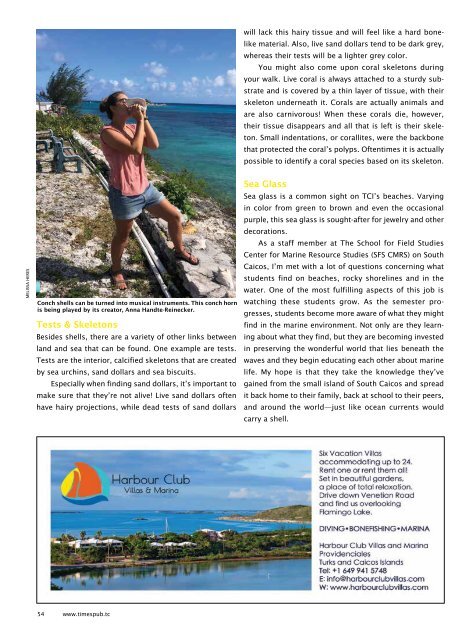Times of the Islands Spring 2021
Presents the "soul of the Turks & Caicos Islands" with in-depth features about local people, culture, history, environment, real estate, businesses, resorts, restaurants and activities.
Presents the "soul of the Turks & Caicos Islands" with in-depth features about local people, culture, history, environment, real estate, businesses, resorts, restaurants and activities.
You also want an ePaper? Increase the reach of your titles
YUMPU automatically turns print PDFs into web optimized ePapers that Google loves.
will lack this hairy tissue and will feel like a hard bonelike<br />
material. Also, live sand dollars tend to be dark grey,<br />
whereas <strong>the</strong>ir tests will be a lighter grey color.<br />
You might also come upon coral skeletons during<br />
your walk. Live coral is always attached to a sturdy substrate<br />
and is covered by a thin layer <strong>of</strong> tissue, with <strong>the</strong>ir<br />
skeleton underneath it. Corals are actually animals and<br />
are also carnivorous! When <strong>the</strong>se corals die, however,<br />
<strong>the</strong>ir tissue disappears and all that is left is <strong>the</strong>ir skeleton.<br />
Small indentations, or corallites, were <strong>the</strong> backbone<br />
that protected <strong>the</strong> coral’s polyps. Oftentimes it is actually<br />
possible to identify a coral species based on its skeleton.<br />
MELISSA HERES<br />
Conch shells can be turned into musical instruments. This conch horn<br />
is being played by its creator, Anna Handte-Reinecker.<br />
Tests & Skeletons<br />
Besides shells, <strong>the</strong>re are a variety <strong>of</strong> o<strong>the</strong>r links between<br />
land and sea that can be found. One example are tests.<br />
Tests are <strong>the</strong> interior, calcified skeletons that are created<br />
by sea urchins, sand dollars and sea biscuits.<br />
Especially when finding sand dollars, it’s important to<br />
make sure that <strong>the</strong>y’re not alive! Live sand dollars <strong>of</strong>ten<br />
have hairy projections, while dead tests <strong>of</strong> sand dollars<br />
Sea Glass<br />
Sea glass is a common sight on TCI’s beaches. Varying<br />
in color from green to brown and even <strong>the</strong> occasional<br />
purple, this sea glass is sought-after for jewelry and o<strong>the</strong>r<br />
decorations.<br />
As a staff member at The School for Field Studies<br />
Center for Marine Resource Studies (SFS CMRS) on South<br />
Caicos, I’m met with a lot <strong>of</strong> questions concerning what<br />
students find on beaches, rocky shorelines and in <strong>the</strong><br />
water. One <strong>of</strong> <strong>the</strong> most fulfilling aspects <strong>of</strong> this job is<br />
watching <strong>the</strong>se students grow. As <strong>the</strong> semester progresses,<br />
students become more aware <strong>of</strong> what <strong>the</strong>y might<br />
find in <strong>the</strong> marine environment. Not only are <strong>the</strong>y learning<br />
about what <strong>the</strong>y find, but <strong>the</strong>y are becoming invested<br />
in preserving <strong>the</strong> wonderful world that lies beneath <strong>the</strong><br />
waves and <strong>the</strong>y begin educating each o<strong>the</strong>r about marine<br />
life. My hope is that <strong>the</strong>y take <strong>the</strong> knowledge <strong>the</strong>y’ve<br />
gained from <strong>the</strong> small island <strong>of</strong> South Caicos and spread<br />
it back home to <strong>the</strong>ir family, back at school to <strong>the</strong>ir peers,<br />
and around <strong>the</strong> world—just like ocean currents would<br />
carry a shell.<br />
54 www.timespub.tc

















